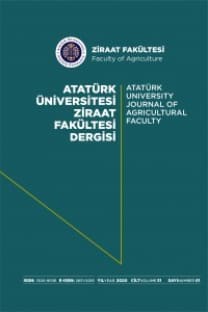HİDROLİK KONDAKTİVİTE TAYİN METOTLARININ ERZURUM OVASI DRENAJ PROBLEM SAHA TOPRAKLARINDA KULLANILABİLME İMKANLARI ÜZERİNDE BİR ARAŞTIRMA
ÖZETErzurum ovasının Yeşilyayla, Muratgeldi, Yolgeçit, Güzelova,çayırtepe, Soğucak köyleri arazilerindeki drenaj problemlerininçözümü için toprakların hidrolik kondakitiviteleriııi tayin etmedemevcut hidrolik kondaktivite tayin _metotlarının kullanılabilme imkanlarımtespit etmek amacıyle yapılmış olan bu araştırmada, araştırmasahasında toprakların hidrolik kondaktiviteleriııin tayini içinpiezometre, well point, bozulmamış numune, hava girışli permeametreVSDA - ses tarafından önerilen tekstür+strüktür kore- , ilasyonu, Hom tarafindan önerilen ortalama tane çapı - permeabilitekorelasyonu metotlarının elveirışli olacakları sonul!Una varılmıştır.ARESEARCH ON THE PRACTIBILITIES OF HYDRAULIC CONDUCTIVITY DETERMINATION METHODS IN THE SOILS OFTHE DRAINAGE PROBLEM AREAS OF ERZURUM VALLEYOne of the most influeneing factorsrelated drainage planning ishydraulic conductivity.Success of a drainage project dependson the determinatian of hydrauJicconductivity which will be the measureof the rea! hydr~ulic conductivity of thesoils with which the project is dealing.Even though selection of the methodfor the deternlination of the hydraulicconductivity among those developedmethods to satisfy our needs bestdepends on the conditions of the soilsin the drainage problem area; it alsodepends on the technical personal andthe availability of necessary equipments.Taking into consideration thesepeculiarities mentioned in the aboveparagraph, this reseaıch has been doneto find the most suitable methods fordetermining the soil permeabilities inthe lands of Yeşilyayla, Muratgeldi,Yolgeçit, Güzelova, Kösemehmet, Çayırtepeand Soğucak viııages which areheavy drainage problem areas of ErzurumvalIey.Twenty-five places having dissimilarprofile characteristics were chosenfor experiments and soil permeabilitieswere determined for different depthsin these places below the water tableby piezometer method. Undisturbed soilcores were taken from the soil 'layerabove the water table for the sameplaces to determine soil permeabilityin the laboratory. Disturbed samplesto represent the soil layers as perfectlyas possible were alsa taken fıom theseplaces, which a piezometer was drivenand undisturbed soİI cores picked,an,d the water used in piezometertests wcre obtained to analyze laterin the laboratory.Structuml and textural anaIyseswere made and va]ues of "soiI pHmeasured İn water" were deteı:mined,chemical analyses were made to determineorganic matter and carbonatein the soil samples; Na+, ca++ +Mg++, pH and electricaI conductivitiesof the water samples were measuredin the laboratory.Undisturbed soiI samples wetesaturated under vacuum and then permeabilitieswere measured by using'constant or falIing head permeameters,however permeability values of disturbedsoiI samples were determined byusing constant head penncameters.Laboratory results indicated thatsoils have textures changing from sandylo!im to elay and medium-high-veryhigh organic matter, however the carbonatecontent of samples vaıied withinlarge limits.Surveyed soiI strata have granuIarıblack, sirıgIe and massiye soil structures.A1though usually massiye structureis observed in lower and granularstructure in upper layers, Lhereare some exceptions.Chemical analyses of the watersamples obtained from the places havingextreme drainage pı oblem indicatedsaline and saline-alkali conditions.The results of the soil permeabi1itytests show that research area soils consistof layers having very different hydraulicconductivities and in addition soilsurveys indicate big differences in thethickness and depth of the soillayers.All of the determined soil propertiesclearly point out the heterogeneouscharacter of research area soils. The(ollowing conclusions are reached,for the potentilal use of the presenthydraulic conductivity determinationmethods in the research area soils,in the light of the knowledge gainedthrough field, laboratory and offiçework:Piezo~eter and Pomana wel1-pointmethods which are used for measuringthe hydraulie conductivity in situhave the possibİ!ity of potential usein layered research area soils. Use ofauger-hole methods could faıse resultsbecause soils are layered and the sensitiyedeliniation of the soil strata withauger is very difricult.Tube method is not advisable farreseaı ch area soijs because of highwater table requirements and surveydifficiulties when water table is high;and also conduetivity measnremenbwith this method is limited to relativelyshallow ,,depths.Childs'two-well, Kirkha:qı's tourweIIand well discharging methods requiresame conditions that are ditricult toobtain or to find in the research area;therefore use of these methods are verylimited.Air entry permeameter methodfor the measurement of penneabilityahove water table was found advantageousto determine hydraulic conductivityof the upper soil strata in the researcharea. The other methods used to measurepermeability above a water table requireexcessive' amount .of materialand time. Hence they were not foundpraetical to use. Determinatio~ of soilpermeability with undisturbed soil co"res need more repIicates than the otheradvised methods because of the sizeand heterogeruty of this area;thereforeit is not suggested as a proper methodfor the drainage surveys.Results of the soil permeabilitytests conducted on djsturbed soil samplesdid not give any carrelation withresults obtained from undisturbed coresand measurements in place, thereforeuse' of disturbed soil samples fordeterınining hydraulic conductivity isnot suitable for research area soils.There are some advisable methodsas mentioned above for direct measurementof permeability in the researcharea, however exceptionally heterogeneouscharacter of the soils and thesize of the drainage problem area whi-chhydraulic conductivity measurementshave to be conducted on is LO 000hectares, therefore use of these methodswill require too much time and effoıt.Those methods requiring less time,in other words indirect permea bjlitydeterminatian; simp1e texture-permeabilitycorrelation did not seem appropriateto use because soil structurehas more influenee than soil textureon the permeability of the researcharea soils. USDA-SCS proposed textur+estructurecorrela tİon method maybe used with great confidenee in thisarea.In order to employ the methodproposed by Ham which uses the mean61parcticle size estimated from texsturalanalysis, some soil texture-permeabilitycurves to represent .the local conditionsmuch better ôhould be obtained forthese parts that the reseaıch area shouldalr~ady have been- divided into, consideringsiınilar soil properties.A~ a. consequence, hydraulic conductivitiescould be determined byin situ measurements to plandraİnagefaciIitief> for sma1J areas; generalization ofthese results obtained from a fewactualmeasurement (no matter how carefuUythis permeability methods chosen forIocal conditions and applied with greatcare) for val1ey soil&, however, couldcost to unneeesessary investment orfailure draİnage facilities which wiUcost a lot of spending.
Anahtar Kelimeler:
-
- ISSN: 1300-9036
- Yayın Aralığı: 3
- Yayıncı: -
